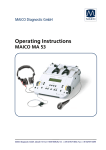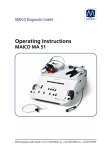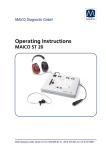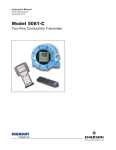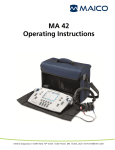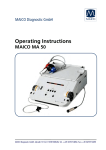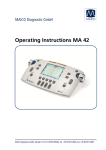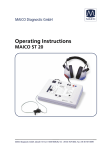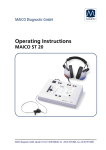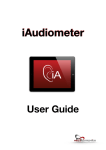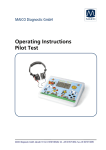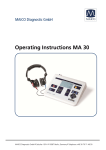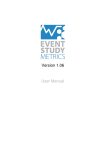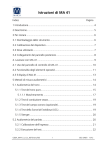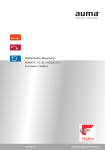Download Operating Instructions MA 52
Transcript
Operating Instructions MAICO MA 52 Operating Instructions MA 52 Table of Contents Page 1 Introduction ............................................................................................. 4 2 Description ............................................................................................... 5 3 Getting started ......................................................................................... 7 3.1 Unpacking your instrument.................................................................... 7 3.2 Preparing the MA 52 for use .................................................................. 8 3.3 Getting familiar with the MA 52 ............................................................ 9 3.3.1 Using the keyboard of the MA 52.................................................. 10 3.3.2 The display of the MA 52 .............................................................. 11 4 Pure tone audiometry ............................................................................. 13 4.1 Air Conduction (AC) Testing ................................................................ 13 4.2 Uncomfortable Hearing Level (UCL) Testing .......................................... 14 4.3 Bone Conduction (BC) Testing ............................................................. 15 4.4 Masking of the opposite ear .............................................................. 15 4.4.1 Crossover: .................................................................................... 16 4.4.2 Masking theory: ............................................................................ 16 4.4.3 Manual masking: .......................................................................... 16 4.4.4 Automatic masking: ...................................................................... 17 4.5 Diagnostic tests ................................................................................... 18 4.5.1 Suprathreshold tests...................................................................... 18 4.5.2 The Stenger Test ........................................................................... 21 4.5.3 The Threshold Decay (Carhart) Test................................................ 21 5 Speech audiometry ................................................................................. 23 5.1 Connecting the speech source ............................................................. 23 5.1.1 Connecting a CD or tape-player .................................................... 23 5.1.2 Connection of Microphone ........................................................... 23 5.2 Speech calibration ............................................................................... 24 5.2.1 Calibration of the CD or tape with speech test material.................. 24 Geba_MA52_e_13a.doc 1 851 408/2 11/11 Operating Instructions MA 52 5.2.1 Calibration of the microphone for live speech test.......................... 24 5.3 Connection and calibration of the monitor phone ................................ 25 5.3.1 Connection of the monitor phone ................................................. 25 5.3.2 Adjustment of the monitor phone ................................................. 25 5.4 Speech Audiometry ............................................................................. 26 5.6 Masking .............................................................................................. 27 6 Quick reference guide ............................................................................ 28 6.1 Startup settings ................................................................................... 28 6.2 Receiver selection ................................................................................ 28 6.3 Signal selection.................................................................................... 28 6.4 How to select tone or speech audiometry mode ................................... 28 6.5 Frequency selection ............................................................................. 29 6.6 Warble tone (FM) ................................................................................ 29 6.7 Pulse tone ........................................................................................... 29 6.8 Suprathreshold tests ............................................................................ 29 6.8.1 SISI Test ........................................................................................ 30 6.8.2 Decay test (Carhart) ...................................................................... 30 6.9 Swap function ..................................................................................... 30 6.10 Tracking function .............................................................................. 30 6.11 STIM Mode selection ......................................................................... 30 6.12 Interlock function .............................................................................. 31 6.13 Talk over microphone ........................................................................ 31 6.14 Talkback microphone and Monitor volume control ............................. 31 6.15 Speech audiometry ............................................................................ 31 6.16 Speech calibration ............................................................................. 31 Geba_MA52_e_13a.doc 2 851 408/2 11/11 Operating Instructions MA 52 6.17 User menu ........................................................................................ 32 7 Recommended literature......................................................................... 33 8 Computer interface ................................................................................ 34 9 Care and maintenance of the instrument ................................................ 34 10 Trouble shooting .................................................................................. 36 11 Technical Data ...................................................................................... 37 12 Warranty, Maintenance and After-Sales Service ..................................... 44 13 Safety Regulations ................................................................................ 45 13.2 Measuring security: ........................................................................... 45 13.3 Device control: .................................................................................. 45 13.4 Operation: ......................................................................................... 45 13.5 Patient Safety: ................................................................................... 45 Checklist for Subjective Audiometer Testing ............................................... 46 Geba_MA52_e_13a.doc 3 851 408/2 11/11 Operating Instructions MA 52 1 Introduction Thank you very much for purchasing a quality product from the MAICO family. This MA 52 audiometer is manufactured to meet all quality and safety requirements, and has been certified with the CE-symbol according to Medical Directive 93/42/EEC. In designing the MA 52 we placed particular importance in making it a userfriendly device, meaning its operation is simple and easy to understand. And because MA 52 functions are software controlled, upgrading later to new, extended measurement functions will be simple and inexpensive. That means that you have invested in a device that will adjust to your future needs. This user manual should make it as easy as possible for you to become familiar with the functions of the MA 52. Please open out the flap of illustrations on the last page. The description of the position (e.g. ➄) of controls, displays and connections, found again in the text, will make it easier for you to learn how to operate the MA 52. If you have problems or have ideas for further improvements, please get in touch with us. Simply call. Your MAICO-team Geba_MA52_e_13a.doc 4 851 408/2 11/11 Operating Instructions MA 52 2 Description The MA 52 is a two-channel audiometer for pure tone and speech audiometric tests. It can be used for ENT diagnostics and hearing aid fittings in the office, and for mobile audiometry in clinics, homes and abroad. Tests can be performed using the TDH 39 headphones (AC), B 71 bone conduction receiver (BC) or optional insert phones and loudspeakers (FF). Built-in test signals are pure tone, pulse tone, warble tone, narrow band and broadband noise. The MA 52 has a microphone for live speech audiometry and an input for an optional tape/ CD player with speech test material. The MA 52 audiometer delivers 11 air conduction (AC) test frequencies from 125 Hz to 8 kHz, with levels from -10 dBHL to 120 dBHL. Bone conduction (BC) can be tested with 11 test frequencies from 125 Hz to 8 kHz with levels from -10 dBHL to 70 dBHL (with the standard bone conductor B 71 the frequency range is limited from 250 Hz to 6 kHz). The optional insert phones EAR 3A submit levels from -10 dBHL to 120 dBHL with 11 test frequencies from 125 Hz to 8 kHz. Optional loudspeakers are available for free sound field measurements (FF). The new, portable loudspeakers MAICO SBC have a dynamic range from -10 dBHL to 80 dBHL at 1m distance, for nine test frequencies from 500 Hz to 8 KHz. The frequency range for speech is 500 Hz to 8 kHz with levels up to 80 dBSPL. The passive loudspeakers from Canton (not available in the USA), deliver levels up to 90 dBHL at 1m distance over the entire frequency range from 125 Hz to 8 kHz. The MA 52 also has separate line level outputs for an external amplifier. The hearing level is controlled independently for each channel by two detented dials on the left and right of the instrument which can be operated from the side or the top. The level steps are 5 dB and can be changed to 2 dB or 1 dB. The signal STIM bar and the frequency up/down keys are just beside the level control knobs for easy one handed control of level, frequency and signal presentation. The large backlighted LCD-display shows level, frequency, transducer, signal and other information for each channel. As a result of modern microprocessor technology, the MA 52 is easy to use and is extremely reliable. Geba_MA52_e_13a.doc 5 851 408/2 11/11 Operating Instructions MA 52 The audiometer is designed to be extremely service friendly. Automatic test programs make trouble shooting and the yearly calibration as easy as possible. PC-Interface: A serial RS 232C interface for data transfer to a connected computer is built in. The optional MAICO-audiometry module for NOAH enables the automatic data transfer of all test results of the MA 52, like speech audiogram and ABLB, DLI, SISI, tone decay etc. For more information see chapter 8. Geba_MA52_e_13a.doc 6 851 408/2 11/11 Operating Instructions MA 52 3 Getting started 3.1 Unpacking your instrument Your MA 52 was carefully inspected and packed for shipping. However, it is a good practice to thoroughly inspect the outside of the shipping box for signs of damage. If any damage is noted, please notify the carrier immediately. Carefully remove the instrument from the shipping box. Remove the plastic bag from the instrument and inspect the case for any damage. Notify the carrier immediately if any mechanical damage is noted. This will assure that a proper claim is made. Save all packing material so the claim adjuster can inspect it as well. Notify your dealer or MAICO when the adjuster has completed the inspection. SAVE ALL THE ORIGINAL PACKING MATERIAL AND THE SHIPPING CONTAINER SO THE INSTRUMENT CAN BE PROPERLY PACKED IF IT NEEDS TO BE RETURNED FOR SERVICE OR CALIBRATION. All accessories are already packaged in the compartment connected with the MA 52. Please check that all accessories listed below are received in good condition. If any accessories are missing or damaged, immediately notify your dealer or MAICO. Standard accessories: 1 Headphone 1 Bone conduction receiver B 71 with headband 1 Patient response switch 1 power cable 1 microphone with stand (only for export outside USA) 1 audiogram form (50 sheets) 1 monitor headset with microphone (USA only) 5 sound room cords (USA only) Calibration of the device: The instrument, headphones, bone conduction receiver as well as the optional insert phone and loudspeaker match one another and have the same serial number (e.g. 6631520). Because they have been calibrated with this particular instrument, use of other transducers is not allowed. If one of the acoustic transducers is replaced, the instrument must be recalibrated. The use of non-calibrated measurements! Geba_MA52_e_13a.doc audiometers 7 leads to incorrect 851 408/2 11/11 Operating Instructions MA 52 3.2 Preparing the MA 52 for use The MA 52 with its integrated compartment for the accessories is perfect for portable use. The rugged housing, light weight and the comfortable handle make it easy and convenient to transport the instrument. Carry it, as shown, with the bottom away from the leg. That helps protect the front cover from damage, and due to the asymmetrical handle position it provides more space for your leg. To get started first move the handle under the housing. Unlatch the cover by pressing in the two black locks located on the left and right sides near the front of the instrument. Open the Picture 1 Transport of MA 52 front cover and rest it on the back cover of the accessory compartment. To open the compartment, press the two black locks in the upper middle of the instrument. Open the compartment cover as seen in picture 2. Take the headphone, the bone conduction receiver, the patient response switch and the microphone out of the compartment and connect the power cable to power. The MA 52 operates with voltages from 100 to 240 V~ AC, 50/60 Hz. To avoid pinching the cables when closing the cover, lay the cables in the slots provided. Close Picture 2 MA 52 with open cover the back cover and latch it with slight pressure. You can place the microphone or a tape or CDplayer on top of the cover (see picture 3). The MA 52 should be operated in a quiet room, so that the audiometric examinations are not influenced by outside noises. For use in noisier environments headphones with optional sound insulation muffs are available. Electro-medical instruments, which emit strong electromagnetic fields (e.g. microwaves radiotherapy devices), can influence the function of the audiometer. Therefore the use of these instruments is not allowed in close Picture 3 MA 52 in operation proximity to the audiometer. The test room must be at normal temperature, usually 15 C / 59 F to 35 C / 95 F, and the instrument should be switched on about 10 minutes before the first measurement to guarantee precise measuring results. If the device has been cooled down (e.g. during transport), please wait until it has warmed up to room temperature. Geba_MA52_e_13a.doc 8 851 408/2 11/11 Operating Instructions MA 52 3.3 Getting familiar with the MA 52 Turn on the instrument with the power switch which is located at the right side of the MA 52. The device performs its initial test and autocalibration. If an error is detected the test is stopped and a description of the error is shown on the LCD-display . In this case please contact your local dealer or service. s above the receiver selectors and and the signal selectors and are lighted. The frequency is set to 1 kHz and the level to 30 dBHL for the left channel, -10 dBHL noise for the right. All these settings are also shown on the display (see picture 5). The hearing level can be easily adjusted independently for each channel with a knob and ↕ on each side of the instrument. For optimal convenience these level control knobs are usable from the top or the side of the instrument. They are detented in 5 dB steps (adjustable to 2 dB or 1 dB). The signal STIM bars and ↔ are located beside the level control knobs , ↕. The signal LEDs and light up when the signal is presented. You can change from presenter to interrupter function with the STIM MODE button . The corresponding LED lights when the interrupter is selected. The frequency is changed with up , → and down , buttons for both channels together. The design of the MA 52 makes it easy to control level, signal presentation and frequency with one hand. Geba_MA52_e_13a.doc 9 Picture 4 MA 52 power switch, display and selection buttons for left and right channel Picture 5 MA 52 display with initial settings Picture 6 MA 52 level and frequency control 851 408/2 11/11 Operating Instructions MA 52 3.3.1 Using the keyboard of the MA 52 All main functions of the MA 52 are directly accessable by pressing a single button. Not frequently used procedures like the calibration of the speech source or the level step selection are hidden as a “second level function”. To select this function just press the addressed button more than two seconds. A user menu for the customization of the MA 52 is available for advanced users (see chapter 6). Following is the description of the main and second level functions of each button: Picture 7 MA 52 keyboard left (blue) channel frequency up: change to next higher frequency left (blue) channel frequency down: change to next lower frequency left (blue) talk over microphone: switches on the talk over microphone as long as the button is pressed. The level can be adjusted with the knobs or ↕. The actual value is displayed in dBHL at the lower center of the LCD-display . left (blue) channel receiver selector: changes the receiver from AC to BC or FF or INSERT (if option assembled). The lighted LED above shows the current selection. 2nd level: selects test mode HL, UCL, MCL for selected receiver (see chapter 4.2) FM - modulation (warble tone): changes test signal from pure tone to warble tone. 2nd. Level: to enter the user menu press button during power on. left (blue) channel signal selector: changes the test signal from pure tone to tape/CD or microphone or noise or switches the channel off. 2nd. Level: Calibration of chapter 5.2) tape/CD or live voice microphone (see pulse tone: enables pulsing of pure tone or warble tone. 2nd. Level: enter pulse tone menu: ABLB, DLI and SISI Test (see chapter 4.5) stim mode: changes the signal presentation from presenter to interrupter mode. 2nd. Level: enables interlock function. Pressing left ➂ or right ↔ signal presentation bar affects both channels. Geba_MA52_e_13a.doc 10 851 408/2 11/11 Operating Instructions MA 52 swap function: exchanges the outputs for both ears (i.e. the right controls now affect the left ear). tracking function: enables the automatic tracking (see chapter 4.4 masking). 2nd. Level: enters level step selection menu. The actual level step is displayed at the lower center of the LCDdisplay . Choose the level steps with the frequency up/down buttons and right (red) channel signal selector key: changes the test signal from pure tone to tape/CD or microphone or noise or switches the channel off. Picture 8 MA 52 keyboard 2nd. Level: adjustment of talkback microphone and monitor phone (see chapter 5.2) right (red) channel receiver selector: changes the receiver from AC to BC or FF or INSERT (if option assembled). The lighted LED above shows the current selection. 2nd level: selects test mode HL, UCL, MCL for selected receiver (see chapter 4.2) right (red) channel talk over microphone: switches on talk over microphone as long as the button is pressed. The level can be adjusted with the knobs or ↕. The actual value is displayed in dBHL at the lower center of the LCD-display . right (red) frequency down: change to next lower frequency right (red) frequency up: change to next higher frequency 3.3.2 The display of the MA 52 The large backlighted graphical LCD-Display of the MA 52 shows all actual settings and test results. The display area is split with a line into an upper or main area and a lower or advanced area (see picture 9). The Picture 9 MA 52 display for BC-test main area shows the individual settings for the left channel on the left and the right channel on the right. General settings which affect both channels are displayed in the middle. The example Geba_MA52_e_13a.doc 11 851 408/2 11/11 Operating Instructions MA 52 picture 9 shows a typical setting for a BC- threshold test. The left channel is bone conduction with 70 dBHL , tone and tracking function enabled. The right channel is set to 90 dBHL narrow band noise with air conduction for masking. The test frequency is 1500 Hz and the test signal is a warble tone. The lower section of the display shows that the talk over microphone button or is pressed and the audiologist talks to the patient with 70 dBHL. The HL in the Picture 10 MA 52 display for speech - test upper row before 1500 Hz indicates that the current measurement is stored as Hearing Level (threshold) test. Picture 10 shows the display for a speech test with speech test material from tape or CD of the left ear and masking of the opposite ear. The left part of the LCD-display shows the settings for the left channel: level = 60 dBHL, receiver = AC, signal = tape/CD. The middle of the LCD-display shows the actual test and the result: MS stands for multi syllable speech test, speech discrimination = 60%, correct words = 6, wrong words = 4. The right part of the LCD-display shows the setting for the right channel: level = 60 dBHL, receiver = AC, signal = speech-noise (masking). The LCD-display has an energy saver function: the backlight of the display is automatically switched out after approximately three minutes. Any action with the MA 52 such as pressing a button or turning the knobs switches the backlight immediately on again. Geba_MA52_e_13a.doc 12 851 408/2 11/11 Operating Instructions MA 52 4 Pure tone audiometry 4.1 Air Conduction (AC) Testing In the hearing threshold test, the hearing threshold of the patient is measured in comparison with the normal hearing threshold for air conduction. The test is started on the ear with better hearing. The patient should sit at a distance of at least 1 m from the device. Eliminate any obstructions which will interfere with the placement of the earphone cushions on the ear (i.e. hair, eyeglasses). Ensure the headphones are put on correctly. Red side on the right, blue side on the left. Picture 11 Headphone Adjust the headband of the headphones so that the receivers are at the correct height (the sound output grid exactly facing the ear canal). Start with the “better” indicated ear at 1 kHz. (After switching on, the frequency is automatically set to 1 kHz.) In the following example we assume that the left is the “better” ear. Set the receiver selector to AC and the signal selector to TONE. Set the left level control knob to a value just below expected hearing loss. Explain to the patient that he should press the button of the patient response switch if he just hears the test tone. Press the STIM bar for a certain time to present the test tone. The STIM LED should light on. If the patient hears the test tone, the patient response display lights red. In this case decrease the level with the level control knob . Proceed with presenting the test signal as described before. t hear the test tone, increase the level with the level control knob . Proceed with presenting the test signal as described before. When you find a stable threshold value, note the level and frequency. If the MA 52 is connected to a PC, the value Picture 12 MA 52 controls and display for airconduction was stored with your last STIM threshold test of the left ear presentation. Geba_MA52_e_13a.doc 13 851 408/2 11/11 Operating Instructions MA 52 - Test through the frequencies. Starting at 1 kHz, set the higher frequencies first then the lower frequencies. Use the frequency up key or → to select the higher frequencies and use the frequency down or to select the lower frequencies. Select the next frequency, increase the level again and proceed with presenting the test signal as described before. Once all frequencies are tested choose the poorer ear and repeat the hearing threshold test. You can do this with the corresponding controls on the other side or just by pressing the SWAP button . The SWAP function enabled means that you measure the right ear using the controls on the left side. The ouput to the left and right earphones are Picture 13 MA 52 display for AC-test with changed. Also, the left and right enabled SWAP function, Pulse and Warble tone display text is changed (see picture 13). The correct marks in an audiogram are: O (red) = right and X (blue) = left Pulse tone: If required, the test can also be performed with a pulsed tone. Press the PULSE button and the pure tone will be switched 0.25s on and 0.25s off. Warble tone: If required, the test can also be performed with a warble tone. Press the FM button and the pure tone will frequency modulate. The warble tone can also be pulsed as described before. For hygienic reasons it is important to clean the ear cushions of the headphone (see chapter 9). 4.2 Uncomfortable Hearing Level (UCL) Testing Testing of UCL can be measured using pure tone stimuli or speech (live voice or tape/CD). The purpose is to determine the dB level at which the stimuli becomes uncomfortable to the patient. This information is valua s upper dynamic range limit for proper hearing aid fittings and for determining symptoms of recruitment. Warning! Because this test uses high sound pressure levels, it is extremly important to perform this test using the utm s MCL (Most Comfortable Level). The UCL level is described as the level between very loud and loud perception of the test signal. Geba_MA52_e_13a.doc 14 851 408/2 11/11 Operating Instructions MA 52 - - Press the receiver selector button or longer than 2 seconds. The LCD-display in the upper row changes from HL to UL (see picture 14). Start as described in chapter 4.1 Picture 14 MA 52 display for UCL-test left with a test level of 60 dBHL. Present the tone briefly (max. 1s) If the signal was recognized by the patient as not uncomfortable increase the level and proceed as described before. If the signal was uncomfortable for the patient note the values. Proceed accordingly with other test frequencies. For hygienic reasons it is important to clean the ear cushions of the headphone (see chapter 9). 4.3 Bone Conduction (BC) Testing Bone conduction, i.e. the transmission of sound waves through the skull directly to the inner ear conways information about the function of the inner ear. For a neural hearing loss the values of air conduction (chapter 4.1) and bone conduction are the same. In this case a hearing Y loss of the middle ear can be eliminated. Place the bone conduction receiver so that Picture 15 Bone conductor the flat, circular side of the transducer Y is placed on the mastoid, at the noticeable ledge of the cranial bone behind the auricle (see picture 16). The other side of the headband is placed in front of the opposite ear. Set the receiver selector or to BC and the signal selector or to TONE. Perform the test the same way as for air conduction (see 4.1). Enter the measurements for all frequencies on the form, connect all points with dotted lines marked on the audiogram form as Picture 16 correct seating of the bone conductor follows: > = right and < = left For hygienic reasons it is important to clean the bone conductor (see chapter 9). 4.4 Masking of the opposite ear The basics of masking are explained below. To begin testing immediately, please go directly to 4.4.3 Manual masking. Geba_MA52_e_13a.doc 15 851 408/2 11/11 Operating Instructions MA 52 4.4.1 Crossover: When measuring a pure tone audiogram you assume that the measured hearing threshold is correct. But if you recognize that sound is also transmitted through bone conduction over the entire skull it is probable that the opposite ear has also received sound. This is called “crossover”. Crossover can also occur when measuring air conduction because a small amount of air conducted sound is received by the skull and transmitted by bone. Whether the crossover signal can heard by the opposite ear depends on its inner ear function. Relevant to crossover is the sound level which is received by the opposite ear. The difference between the original test signal at the test ear and the received signal at the opposite ear is called “interaural attenuation”. For bone conduction measurement the interaural attenuation is 0 to 15 dB. Bone conduction crossover is therefore possible even with a slight difference in hearing loss between ears. Important: Please advise the patient to tell you in which ear he hears the test signal. It is thereby easier to detect crossover. 4.4.2 Masking theory: To ensure that the patient will not experience crossover you must mask the opposite ear. Masking increases the hearing threshold of the opposite ear. The masking is done with a noise signal which is transmitted by the headphone. For pure tone audiometry a narrowband noise is used. This noise changes its center frequency according to the frequency of the test signal. 4.4.3 Manual masking: If you have to mask use the common masking rules. See chapter 7 for recommend literature. Masking is an important part of practical audiometry. It is necessary to be familiar with this topic to avoid errors which would lead to a wrong diagnosis. - For the opposite ear set the receiver selector or to AC and the signal selector or to NOISE. Adjust the required masking level with the level control knob or ↕. Notice that the masking sound is continuously presented for effective masking. You can interrupt the masking signal by pressing the corresponding Picture 17 Headphone interrupter key or ↔. To mask when performing bone conduction testing, place the headphone on the opposite ear so that the receiver is at the correct height (the sound output grid exactly faces the ear canal). Adjust the headband of the headphones. The receiver on the side where the bone conductor is placed should sit directly on the cheek bone. Geba_MA52_e_13a.doc 16 851 408/2 11/11 Operating Instructions MA 52 The marking for air conduction with masking should be done with the symbols = the right side and ■ = the left side on the audiogram form. The marking for bone conduction with masking should be done with the symbols [ = the right side and ] = the left side on the audiogram form. 4.4.4 Automatic masking: With the manual masking, as described before, you have to readjust the masking level every time you change the test signal level. The MA 52 has a tracking feature for easy masking. Adjust for the test signal using the level control knob or ↕, then with the opposite level control knob or adjust for the corresponding masking level. Now press the TRACK button . The masking level is automatically changed if you adjust the Picture 18 correct seating test signal level. (e.g. if the test level was 30 dB of the bone conductor and the masking level 50 dB and you change the test level to 45 dB the masking level is automatically adjusted to 65 dB. Picture 19 MA 52 display for bone conduction with masking and enabled tracking function Geba_MA52_e_13a.doc 17 851 408/2 11/11 Operating Instructions MA 52 4.5 Diagnostic tests 4.5.1 Suprathreshold tests The MA 52 offers additional suprathreshold tests which can offer more information about the kind of the hearing loss. To access suprathreshold tests press the PULSE button longer than two seconds. The suprathreshold test menu is now displayed on the lower part of the LCD- Picture 20 MA 52 display with display (see picture 20). The actual suprathreshold menu choice is displayed inversely. You can toggle through the different options by briefly pressing the PULSE button . Start the chosen option by pressing the STIM bar or ↔.To exit the Supratreshold test menu briefly press the FM button . 4.5.1.1 The ABLB (Fowler) Test The Alternate Binaural Loudness Balance test is a recruitment test which uses the presentation of alternating tones between the two ears with headphones. The intensity of the tone in the hearing-impaired ear is varied until the loudness of the tone is judged by the patient to be equivalent to a tone at a constant intensity in the normal ear. This is called loudness balance. The test is done for various intensity levels in the normal ear. To start the test select 0.5 sec. or 1 sec. modulation time in the suprathreshold menu (as decribed before under 4.5) and press the STIM bar or ↔. On the LCD-display is ABL with the chosen modulation time shown (see picture 21). Adjust the desired hearing levels for both the normal ear and the impaired ear using the level control knobs and ↕. Press the STIM MODE button to Picture 21 MA 52 display with ABLB test present the signal continuously. Now change the level for the hearing-impaired ear with the level control knob ↕ or until the patient indicates that the loudness in both ears is equal. Note the levels and proceed with other levels and frequencies as required. To exit the test briefly press the PULSE button . Geba_MA52_e_13a.doc 18 851 408/2 11/11 Operating Instructions MA 52 4.5.1.2 The DLI (Lüscher) Test The Intensity Difference LImen for loudness test (or Just Noticeable Difference, JND) is another recruitment test. A pure tone is amplitude modulated at a rate of 2/second. The patient has to determine whether this signal was steady or undulating (beating). To start the test select a modulation ´ amplitude from 0.5 dB to 4.0 dB in the suprathreshold menu (as decribed before under 4.5) and press the STIM bar or ↔. The LCD-display shows DLI, along Picture 22 MA 52 display with DLI test with the chosen modulation amplitude (see picture 22). Now adjust the required test level with the level control knob or ↕ and present the test signal by pressing the STIM bar or ↔. To exit the test press the PULSE buttom longer than 2 seconds. The Supratreshold tests menu is now displayed. To exit the Supratreshold test menu briefly press the FM button . 4.5.1.3 The SISI Test The SISI (Short Increment Sensitivity Index) is guided by the principle that patients with cochlear impairment are hypersensitive to small intensity increments. The continuous test tone is increased by 1 dB for a period of 0.2 seconds every 4.8 seconds. Whenever the patient hears the increment, he/she presses the patient response switch. The SISI test information and the test score are shown on the LCD-display . The test will end automatically after 20 presented increments. The score is expressed as a percentage of ratio of the increments heard to the delivered increments (all increments heard = 100% - no increments heard = 0%). A high score indicates a cochlear impairment. A low score is related to normal hearing or conductive or retrocochlear pathology. 4.5.1.3.1 Preparation of the SISI Test To start the test select SISI in the suprathreshold menu (as decribed before under 4.5) and press the STIM bar or ↔. The display changes to the SISI conditioning screen (as shown in picture 23). Select the test frequency with the frequency keys / or /. For the test you should choose the frequency where the maximum bone conduction hearing loss is measured as described in chapter Picture 23 MA 52 display with 4.3. SISI conditioning 5dB Adjust test level with the level Geba_MA52_e_13a.doc 19 851 408/2 11/11 Operating Instructions MA 52 - control knob or ↕. The level should be set to a value 20 dB above the individual hearing threshold (measured under chapter 4.1). It must reach at least 60 dBHL. Recognize that in the SISI mode the test signal is presented continuously. You can interrupt the test by pressing the STIM bar or ↔ for however long you hold it down. The patient must be instructed: "You will now hear a continuous tone. Every time it becomes louder, immediately push the switch”. 4.5.1.3.2 Training of the Patient Only with careful training during the following conditioning phase can a valid test result be achieved. The training starts with a modulation level of 5 dB. That Picture 24 MA 52 display with SISI means a continuous tone, e.g. 65 conditioning 5dB and presented increment dBHL, is briefly increased every 4.8 seconds for 0.2 seconds by 5 dB, e.g. to 70 dBHL. During the increment time the text “Tone Now” is shown on the lower area of the LCD display (see picture 24). The text “Answer now” appears for approx. 1.5 seconds. During this period the patient may respond. If he/she answers too early or too late the answer will not be accepted by the MA 52. The number of detected increments is counted and shown on lower right area of the display. Furthermore, the number of presented increments is shown (see picture 24). When you are sure that the patient has understood the object of the test, press the the PULSE button . The modulation level will be changed to 3 dB. If the patient has understood this part of the test also, press the the PULSE button again. The modulation level will be reduced to 2 dB. 4.5.1.3.3 SISI Test If the patient has understood the test up to here, press the PULSE button again to start the SISI test. The LCD-display indicates SISI test (see picture 25) and the modulation Picture 25 MA 52 display with SISI test level is adjusted to 1 dB. Now 20 increments will be presented to the patient. You can delay the test for the time you press STIM bar or ↔. This could be helpful in detreming if the patient malingers. Geba_MA52_e_13a.doc 20 851 408/2 11/11 Operating Instructions MA 52 - The test will end automatically after 20 presented increments. The number of detected increments is counted and indicated as percentage of the presented increments (see picture 26). - If you are sure that the result of the test is consistent you can abort the test at any time by pressing the PULSE button . The result is then indicated accordingly (picture 27). Retrocochlear hearing impairment is represented by low scores (< 25 %), cochlear defects by high scores (> 70 %). Press any button leave the SISI test. - - Picture 26 MA 52 display with SISI result 4.5.2 The Stenger Test The Stenger test is conducted as a malingering test in cases of alleged hearing loss or unilateral deafness. It is based on the premise that when two tones of the same Picture 27 MA 52 display with aborted SISI frequency are presented simultaneously into test both ears, only the louder tone will be perceived. The patient with a feigned hearing loss will not be able to hear the quiet tone, but will also not admit being able to hear the luod tone. Select the desired frequency with the frequency keys / or / and adjust the sound intensities with the level control knobs and ↕. Present the tone with the STIM bars and ↔. The easiest procedure is to present the desired frequency into the better ear at a level of 10 dB above the threshold. At the same time present the signal into the poorer ear (the one with the possible feigned loss) at a level 10 dB below the admitted threshold. If the loss in the poorer ear is real, the patient will be unaware of the signal in that ear and will respond only to the tone in the good ear. If the patient does not respond at all it is likely the admitted threshold is incorrect and you have a “positive” Stenger. 4.5.3 The Threshold Decay (Carhart) Test This examination is conducted as a fatigue test in cases of sensitivity loss. Select the desired frequency with the frequency keys / or /. Adjust the sound level to a value about 5 dB above their hearing threshold with the level control knob or ↕. Instruct the patient to start pressing the patient response switch when he hears a tone and to release the switch when he doesn’t hear the tone anymore. Geba_MA52_e_13a.doc 21 851 408/2 11/11 Operating Instructions MA 52 - - - Enter continuous tone presentation by pressing the STIM MODE button to present the test signal or press the corresponding STIM bar or ↔. The PAT response LED lights and after two seconds a bar stop watch with a scale from 0 to 60 seconds appears on the lower area of the LCD-display (see picture 28). When the patient releases the switch Picture 28 MA 52 display with the bar of the stop watch stops and initial tone decay test you can see the time the patient heard the tone (see example picture 29). If the time was less than 60 seconds increase the level with the level control knob or ↕ by 5 dB. Press any button to erase the stop watch on the display and start the Picture 29 MA 52 display with test again. example tone decay test Continue this procedure until the patient can hear the tone at least for 60 seconds. The threshold shift can be entered on the tone audiogram pad by drawing a wavy line under the selected frequency. Geba_MA52_e_13a.doc 22 851 408/2 11/11 Operating Instructions MA 52 5 Speech audiometry 5.1 Connecting the speech source 5.1.1 Connecting a CD or tape-player To conduct speech tests using speech test material you can connect a CD- or tapeplayer to the MA 52. Use a standard phono plug cable to connect the right and left outputs of the device with the corresponding inputs and on the rear panel of the MA 52 (see picture 28). To avoid pinching the cables when closing the cover, lay the cables in the slots provided. If you are using a small portable CD-player or tape you can place it on top of the cover of the MA 52 as shown in picture 29. This saves space and makes the usage of the CD-player or tape very convenient. Caution: If you are using a CD- or tapeplayer powered by electrical current, the player must meet electrical safety requirements, such as IEC 601-1 or UL. This is to avoid electrical shock of either the patient or you. If you are not sure if your player meets these requirements it is safer to use battery power. 5.1.2 Connection of Microphone Connect the microphone to the SPEECH MIC connector on the rear panel of the MA 52 (see picture 32). To avoid pinching the cables when closing the cover, lay the cables in the slots provided. Place the microphone on top of the cover of the MA 52 (as shown in picture 31). The microphone can be used for live speech audiometry and communication with the patient. If your instrument is supplied with a monitor/mic headset, connect the phone plug labeled M with the SPEECH MIC connector . Geba_MA52_e_13a.doc 23 Picture 30 MA 52 rear panel with TAPE/CD input Picture 31 MA 52 in operation with portable CD-player Picture 32 MA 52 rear panel with SPEECH MIC input 851 408/2 11/11 Operating Instructions MA 52 5.2 Speech calibration 5.2.1 Calibration of the CD or tape with speech test material The MA 52 must be calibrated to the particular speech test material in use to ensure valid test levels. That means every time you change the CD or tape you must recalibrate the instrument. To calibrate the Tape/CD speech input select TAPE/CD with the left SIGNAL selector key . Press the left SIGNAL key longer than 2 seconds. In the lower area of the display the text Calibration appears. You also see the actual settings in % of 33 MA 52 controls and displays the maximum calibration for both Picture for speech calibration channels (see picture 32). On every CD or tape with speech test material you have a reference signal, such as a reference tone or speech simulating noise. Perform the reference signal with Picture 34 MA 52 display with Tape or CD. Use the left knob for the left speech calibration of CD-player or tape channel and the right knob ↕ for the right channel and adjust the levels until both VU-meters and show all yellow and one green light. If one or more red lights are on, reduce the level using the corresponding knobs or ↕. Store the calibration by pressing the STIM bar or ↔. 5.2.1 Calibration of the microphone for live speech test - To calibrate the SPEECH MIC input select MIC with the left SIGNAL selector key . Press the left SIGNAL key longer than 2 seconds. Picture 35 MA 52 display with In the lower area of the display the speech calibration of the microphone text Calibration appears. You also see the actual settings in % of the maximum calibration for both channels. Position yourself the customary distance from the microphone and speak test words. Geba_MA52_e_13a.doc 24 851 408/2 11/11 Operating Instructions MA 52 - Use the left knob to adjust the level until both VU-meters and show all yellow and one green light. If one or more red lights are on, reduce the level using the knob . Store the calibration by pressing the STIM bar or ↔. 5.3 Connection and calibration of the monitor phone 5.3.1 Connection of the monitor phone Connect the monitor phone plug E to the MONITOR connector at the rear panel of the MA 52 (see picture 34).To avoid pinching the cables when closing the cover, lay the cables in the slots provided. The monitor phone allows you and the patient to hear the speech test material simultaneously. This helps in determining if the test word was understood by the patient. If the talk back option of the MA 52 is installed, the communication from the patient to audiologist will be heard with the monitor phone. Picture 36 MA 52 rear panel with MONITOR phone output 5.3.2 Adjustment of the monitor phone To adjust the output level of the monitor phone press the right SIGNAL key longer than 2 seconds. In the lower right area of the display the text Monitor appears. Below that you see the actual settings in % Picture 37 MA 52 display with of the maximum output level (see adjustment of the monitor phone picture 37). Perform a test signal with Tape, CD or the talk back microphone (if installed). Use the right knob ↕ and adjust the output level that is comfortable for you. Store the adjustment by pressing the STIM bar or ↔. Geba_MA52_e_13a.doc 25 851 408/2 11/11 Operating Instructions MA 52 5.4 Speech Audiometry The speech-recognition threshold SRT is the hearing threshold for speech.It is the lowest level at which the patient correctly recognizes the stimuli 50% of the time. Usually, recognition is indicated by repetition of the speechstimulus item. The speech test can be done with recorded speech test material from CD or tape or with the microphone and live voice using standardized word lists. Different methods for speech tests are standardized worldwide such as the ASHA guidlines for determining the threshold level for speech (Asha 21, page 353-356). Explain to the patient that he should repeat each word he hears. The patient should sit at a distance of at least 1 m from the device. Eliminate any obstructions which will interfere Picture 38 Headphone with the placement of the earphone cushions on the ear (i.e. hair, eyeglasses). Ensure the headphones are put on correctly. Red side on the right, blue side on the left. Adjust the h eadband of the headphones so that the receivers are at the correct height (the sound output grid exactly facing the ear canal) Set the receiver selectors and to AC and the signal selectors and both to TAPE/CD (if you are using recorded speech test material) or to MIC (if you wish to perform a speech Picture 39 MA 52 display with test with live speech). initial settings for speech audiometry On the LCD-display the initial setting for speech audiometry (see picture 37) appears. The percent speech discrimination score is displayed in the middle. Below this, the number of correct and incorrect words is shown. If you are using CD or tape, put the monitor phone on to hear the test words. Depending on your test method, use the level control knob or ↔ to set the start level. Perform the test words. Tally the correct words by pressing the frequency up key or →. Tally the incorrect words by pressing the frequency down key or . When you finish a word list, note the percentage of the speech discrimination score. In the example shown in picture 38, one half of the words were heard correctly. If you are working online with a PC press the STIM bar or ↔ to transfer the test result to the PC (see also chapter 8). Geba_MA52_e_13a.doc 26 851 408/2 11/11 Operating Instructions MA 52 - - To clear the counter for the next test, press the FM key . It is also possible to perform the speech test with loudspeakers (e.g. for the verification of hearing aid fitting) or bone conduction. Select the required transducer with the RECEIVER selection button or and proceed as described before. Picture 40 MA 52 display with typical result for speech audiometry 5.6 Masking Speech audiometry has similar masking rules to those desribed in chapter 4.4 for pure tone audiometry. When TAPE/CD or MIC is selected on one channel, and NOISE masking on the opposite channel, the MA 52 automatically performs speech masking noise. Geba_MA52_e_13a.doc 27 851 408/2 11/11 Operating Instructions MA 52 6 Quick reference guide 6.1 Startup settings Air conduction on both channels Pure tone on both channels 30dBHL on both channels Presenter mode 6.2 Receiver selection Press either the right or left RECEIVER key to select the receiver (AC, BC, FF, INSERT). The display shows the selected receiver below the levels. Not available receivers will be skipped. It is not possible to select bone on both channels simultaneously. After a new selection the level will be reset to 30dBHL. 6.3 Signal selection Press either the right or left SIGNAL key to select the signal. The kind of NOISE signal depends on the signal of the opposite channel. Speech masking noise is used if on the opposite channel the speech signal is selected. (see 6.4 below). The display shows the selected signal below the receiver text. The 5. Position is signal off. The light at the signal key or and the STIM LED or is off and the level in the display is erased. 6.4 How to select tone or speech audiometry mode There are two modes of audiometry. Tone audiometry : shows level and frequency on the display Speech audiometry : shows level, correct and incorrect words and speech discrimination in percentage on the display Geba_MA52_e_13a.doc 28 851 408/2 11/11 Operating Instructions MA 52 This table shows how to select one of these modes: Signal left Signal right Mode Tone Tone Tone Tone Noise (NBN) Tone Tone Tape/CD or LV Tone Noise (NBN) Tone Tone Tape/CD or LV Tone Tone Tape/CD or LV Tape/CD or LV Speech Tape/CD or LV Noise (Speech) Speech Noise (Speech) Tape/CD or LV Speech 6.5 Frequency selection Use one of the two sets of frequency keys / or / to select the frequency. The maximum and minimum frequency depends on the receiver you have selected. 6.6 Warble tone (FM) Press the FM key to activate the warble tone. Warble is shown in the display . Press the FM key again to switch back to pure tone. 6.7 Pulse tone Press the PULSE key to activate the pulse tone. Pulse is shown in the display and the light above the PULSE key is on. Press the PULSE key again to deactivate pulsing. 6.8 Suprathreshold tests Press the PULSE key longer than 2 seconds. In the lower area of the display the parameters of the ABLB, DLI and SISI test are shown. Using the PULSE key, select the test and parameter. Press one of the STIM bars or ↔ to select your choice. The lower area of the display is cleared and the selected test is shown on the display . The light above the PULSE key is on. To change to another parameter press the PULSE key again and hold longer than 2 seconds. To end the selected test, press the PULSE key briefly. Geba_MA52_e_13a.doc 29 851 408/2 11/11 Operating Instructions MA 52 6.8.1 SISI Test Once SISI is selected, the test begins immediately by conditioning in 5dB increments. Press the PULSE key again to enter the next levels of SISI conditioning (3 dB, then 2 dB) and to start the SISI test (1dB). During the test the display shows the increment level, the number of presented increments and the number of correct answers given by the patient. In addition, “Tone Now“is displayed when an increment is presented and “Answer Now“is displayed during the answer acceptance time. During SISI-conditioning it is possible to clear the counters by pressing the FM key . To cancel the conditioning and the SISI test and to return to standard operation press the SWAP key . After 20 increments the SISI test is finished. The text SISI Result with the result in percentage is shown. You can stop the SISI test with the PULSE key . The text SISI aborted and the actual result in percentage is shown. Press the PULSE key to quit the SISI test. 6.8.2 Decay test (Carhart) If the patient presses the patient response switch longer than 3 seconds, in the lower area of the display a decay bar appears and shows the counted time until the patient releases the patient response switch. To clear the display and reset the decay function press one of the STIM bars or ↔. 6.9 Swap function Press the SWAP key to exchange the left and right channel. The big letters R and L will be swapped in the display and the light above the SWAP key is on. Press the SWAP key again to deactivate swapping. 6.10 Tracking function Press the TRACK key to activate tracking. Both the left and right sides of the display will say TRACKED, meaning that both channels are tracking each other. If NOISE is selected on one channel, the text TRACKED is erased, because a noise channel is not allowed to track a signal channel. Press the TRACK key again to deactivate tracking. 6.11 STIM Mode selection Press STIM MODE key to switch between continuous presentation and presentation by pressing the STIM bar or ↔. When in continuous presentation mode the STIM bars and ↔ function as interrupters. The light above the STIM MODE key is on if continuous presentation is selected. Speech and noise are always in continuous presentation, except when both channels are selected as noise. Geba_MA52_e_13a.doc 30 851 408/2 11/11 Operating Instructions MA 52 Press the STIM MODE key again to deactivate continuous presentation. 6.12 Interlock function Press the STIM MODE key longer than 2 seconds to activate the interlock function. The display shows the text Interlock. Interlock works only if both channels have the same kind of signal (Speech, tone or noise). In modes where no interlock is available the display shows No Interlock. Press the STIM MODE key longer than 2 seconds to deactivate the interlock function. 6.13 Talk over microphone Press one of the TALK OVER keys and . In the lower area of the display the volume level of the talk over microphone is shown. Adjust the talk forward volume with the left or right ↕ knob. Release the TALK OVER key or if you have finished talking to the patient. 6.14 Talkback microphone and Monitor volume control Press the right SIGNAL key longer than 2 seconds and the volume control bars for TB and monitor are shown. Adjust the monitor volume with the right knob ↕. Adjust the talkback microphone volume with the left knob . To store the actual settings press one of the STIM bars or ↔. 6.15 Speech audiometry To select speech audiometry switch both channels to TAPE/CD or MIC by using the SIGNAL selector keys and . In speech mode the display shows the percentage of correct repeated words. Below this percentage the number of correct and wrong receipted words is shown. To count the correct words press one of the frequency up keys or →. To count the wrong words press one of the frequency down keys or . To clear the counter press the FM key . 6.16 Speech calibration To calibrate the speech inputs Tape/CD or MIC select the signal you’d like to calibrate with the left SIGNAL selector key . Press the left SIGNAL key longer than 2 seconds. In the lower area of the display the text Calibration appears. Perform the reference signal with Tape, CD or microphone. Use the left knob for the left channel and the right knob ↕ for the right channel and adjust the levels until both VU-meters and show all yellow and one green light. If one or more red lights are on, reduce the level using the corresponding knobs or ↕. Store the calibration by pressing the STIM bar or ↔. Geba_MA52_e_13a.doc 31 851 408/2 11/11 Operating Instructions MA 52 6.17 User menu To enter the User Menu you have to press the FM key during instrument switch-on. To choose an item from the menu use the FREQUENCY keys / or /. To select the chosen item press one of the STIM bars or ↔. Change the actual setting with the FREQUENCY keys / or /. To confirm the changed setting press one of the STIM bars or ↔. To return without change press the FM key . To return to the standard operation press the FM key at the user menu. These menu items are available : FF Set 1/2* Select the calibration for the first or the second loudspeaker set Bin Monaural Select the signal source channel for CD/TAPE (Bin/Left/Right) User Setup Individual settings User Performance Selection of different options for the user The items of the two menus User Setup and User Performance are self explaining * = only accessable if option is purchased Geba_MA52_e_13a.doc 32 851 408/2 11/11 Operating Instructions MA 52 7 Recommended literature Audiometric Interpretation: A Manual of Basic Audiometry Lloyd, Lyle L., and Harriet Kaplan Baltimore: University Park Press, 1980 Auditory Disorders: A Manual for Clinical Evaluation Jerger, Susan, and James Jerger Boston: College Hill Press, 1981 Handbook of Clinical Audiology Katz, Jack Baltimore: William & Wilkins, 1994 s Audiology Desk Reference Roeser, Ross J. New York / Stuttgart: Thieme, 1996 Auditory Diagnosis Geba_MA52_e_13a.doc Silam, Shlomo and Carol A. Silvermann San Diego / London: Singular Publishing Group, 1997 33 851 408/2 11/11 Operating Instructions MA 52 8 Computer interface The MA 52 can be connected for data transfer to a PC. Caution: The computer you are using must meet electrical safety requirements, such as IEC 601-1 or UL. This is to avoid electrical shock of either the patient or you. All test results are online transferred to the PC and stored in the database. ‒ In pure tone audiometry initially all measured data is transferred as Picture 41 MA 52 display with hearing threshold data. You can see pure tone threshold setting the letters HL meaning threshold measurement in the upper middle of the LCD-display (see picture 41). - To test the uncomfortable level (UCL) press the receiver selector button or longer than 2 seconds and the LCDdisplay in the upper row changes from HL to UL. All measured data is now transferred as UCL data. - To test the most comfortable level speech setting (MCL) press the receiver selector button or longer than 2 seconds and the LCD-display in the upper row changes from UL to ML. All measured data is now transferred as MCL data. - In speech audiometry initially all measured data is transferred as multisyllable test data. You can see the indication MS in the upper middle of the LCD-display (see picture 42). Picture 42 MA 52 display with - To test with single syllables press the receiver selector button or longer than 2 seconds and the LCD-display in the upper row changes from MS to SS. All measured data is now transferred as single syllable test data. To test the uncomfortable level (UCL) for speech press the receiver selector button or longer than 2 seconds and the LCD-display in the upper row changes from SS to UL. All measured data is now transferred as UCL speech data. 9 Care and maintenance of the instrument Geba_MA52_e_13a.doc 34 851 408/2 11/11 Operating Instructions MA 52 Disconnect the power plug before cleaning! To clean the instrument, headphones, bone conduction receiver, loudspeaker and other accessories use a soft cloth dampened with a little warm soapy water or washing-up liquid; no alcohol or spirits should be used. The ear cushions Z of the headphone can be detached for cleaning. To remove the ear cushion Z pull it gently from the earphone. To assemble the cleaned or changed ear cushion press it on the earphone and make sure that it sits properly. The sound outlet hole must be exactly in the middle of the earphone. - Picture 43 changing of the ear cushions During cleaning, please ensure that no liquid runs into the switches, level control, headphone capsules or loudspeaker openings. Geba_MA52_e_13a.doc 35 851 408/2 11/11 Operating Instructions MA 52 10 Trouble shooting If you should find that your instrument is no longer working properly during a test run, please check the following points: Diodes in the buttons do not light up and there is nothing to see on the LCD-display : Is the power cord plugged in correctly? - Check the power fuses ♦. Disconnect the power plug, unscrew the fuses alongside the power cord socket and check the fuses. If the wire in the glass vial is broken, please insert new fuses (1 A slow blow). Picture 44 power socket and fuses Diodes light up, but test tone is absent: Green STIM LED or does not light: Press STIM bar or (When the diode lights up and the tone is available, the device works in presenter mode). - Green STIM LED or does light: Is level control or ↕ set to an audible level position? Are the acoustic receivers connected to the correct socket? Is the required receiver with button or selected - is the correct LED lit? Is the lead connecting the headphones, bone conductor or loudspeaker loose or defective? If your instrument still does not work properly after this short check, please consult your dealer or service center. Geba_MA52_e_13a.doc 36 851 408/2 11/11 Operating Instructions MA 52 11 Technical Data The MA 52 audiometer is an active, diagnostic medical product according to the class IIa of the EU medical directive 93/42/EEC. Standards: IEC 601-1 class II, protection class BF IEC 645-1: Type 2 IEC 645-2: Type A ANSI S3.6-1996 : Type 2 B Test-Frequencies: 125 Hz, 250 Hz, 500 Hz, 750 Hz, 1 kHz, 1.5 kHz, 2 kHz, 3 kHz, 4 kHz, 6 kHz, 8 kHz Level step: 5 dB, 2 dB or 1 dB level steps (user selectable) Sound Pressure Level: AC with earphone: (500 Hz, 4 kHz -10 - 10 dBHL ... 120 dBHL dBHL ... 115 dBHL) (250 Hz, 8 kHz -10 dBHL ... 100 dBHL) (6 kHz -10 dBHL ... 110 dBHL) (125 Hz -10 dBHL ... 80 dBHL) BC with bone conduction receiver Radioear B 71: - 10 dBHL ... 70 dBHL (500 Hz, 750 Hz, 4 kHz, 6 kHz -10 dBHL ... 60 dBHL) ( 250 Hz -10 dBHL ... 45 dBHL) ( 125 Hz, 8 kHz no output ) ( speech -10 dBHL ... 80 dBHL) Insert earphone with optional EAR 3A: - 10 dBHL ... 120 dBHL ( 750 Hz, 1.5 kHz -10 dBHL ... 115 dBHL) ( 500 Hz, 4 kHz -10 dBHL ... 110 dBHL) ( 250 Hz -10 dBHL ... 105 dBHL) ( 6 kHz -10 dBHL ... 95 dBHL) ( 125 Hz -10 dBHL ... 90 dBHL) ( 8 kHz -10 dBHL ... 85 dBHL) FF with optional loudspeaker type Canton: (not available in USA) - 10 dBHL... 90 dBHL (measurement in 1m distance) ( 1 kHz, 1.5 kHz -10 dBHL ... 85 dBHL) ( 500 Hz, 750 Hz -10 dBHL ... 80 dBHL) ( 250 Hz, 6 kHz, 8 kHz -10 dBHL ... 75 dBHL) ( 125 Hz -10 dBHL ... 60 dBHL) ( speech -10 dBHL ... 85 dBHL) FF with optional portable loudspeaker MAICO SBC: (measurement in 1m - 10 dBHL... 85 dBHL distance) Geba_MA52_e_13a.doc 37 851 408/2 11/11 Operating Instructions MA 52 ( 750 Hz, 2 kHz, 8 kHz -10 dBHL ... 80 dBHL) ( 500 Hz, 6 kHz -10 dBHL ... 75 dBHL) (125 Hz, 250 Hz no output ) ( 2 kHz, 6 kHz -10 dBHL ... 90 dBHL) ( 3 kHz, 4 kHz -10 dBHL ... 100 dBHL) Test Signal: Pure tone, pulse tone, warble tone, narrowband noise, broadband noise (speech masking noise) Modulation: Pulse tone: 0.5 s on/off Warble tone: triangular, freq. devitation 5%, repetition rate 5 Hz Tests: ABLB (Fowler): 0.5 s and 1 s DLI (Lüscher): 4; 3; 2; 1.5; 1 and 0.5 dB SISI test: 5 dB, 3 dB, 2 dB conditioning; 1 dB test; Modulation time 4.8/0.2s Carhart decay test (built-in stop watch) Stenger test Functions: Tone presenter / interrupter Interlock (tone presentation of both channels simultaneously) Channel swap Tracking (fixed level difference between both channels) Warm up time: less than 10 min after power on Mode of operation: continuous Environment conditions: + 15 ... + 35 C / + 59 ... + 95 F (operation) + 5 ... + 50 C / + 41 ... + 122 F (storage) Maximum humidity 90 % (storage and operation) According to water: ordinary equipment According to sterilization: not applicable Dimensions: W x D x H: 36 x 46 x 15 cm / 14.2” x 18.1” x 5.9” Weight: 4.6 kg / 10.1 lbs (with accessories 5.8 kg / 12.8 lbs) Power Supply: 100 - 240 V~ 50/60 Hz ±10 % Power Consumption: app. 25 VA Device Fuses: 2x 1A slow blow Geba_MA52_e_13a.doc 38 851 408/2 11/11 Operating Instructions MA 52 Connection plugs: power socket power fuses serial PC-interface Connection left/right=power, middle=prot.GND Specification (100 ... 240 V~ 50/60 Hz) 1 A slow blow 1=GND, 2=RX, 3=TX, RS 232 C 5=GND, 6=DTR RI= 500 Ω patient response switch sleeve=GND, tip=in signal output right sleeve=GND, tip=out ZA= 47 k, UA= 8 Veff signal output left sleeve=GND, tip=out ZA= 47 k, UA= 8 Veff FF (loudspeaker) right channel sleeve=GND, tip=out ZA= 4 , UA= 8 Veff FF (loudspeaker) left channel sleeve=GND, tip=out ZA= 4 , UA= 8 Veff masking phone for BC (option)sleeve=GND, tip=out ZA=10 , UA=1 Veff tape/CD input right channel sleeve=GND, tip=in ZI= 47 k, UI= 0.04 - 5 Veff tape/CD input left channel sleeve=GND, tip=in ZI= 47 k, UI= 0.04 - 5 Veff BC (bone conduction receiver) sleeve=GND, tip=out ZZA= 4 , UA= 8 Veff monitor phone sleeve=GND, tip=out ZA= 250 , UA= 8 Veff insert phone right channel sleeve=GND, tip=out ZA=10 , UA=1 Veff talkback microphone sleeve=GND, tip=in ZI= 1 k, UI= 0.38 - 500 mVeff insert phone left channel sleeve=GND, tip=out ZA=10 , UA=1 Veff AC (headphone) right channel sleeve=GND, tip=out ZA=10 , UA=1 Veff live voice microphone sleeve=GND, tip=in ZI= 1 k, UI= 0.38 - 500 mVeff AC (headphone) left channel sleeve=GND, tip=out ZA=10 , UA=1 Veff Picture 45 rear of MA 52 with connection plugs Geba_MA52_e_13a.doc 39 851 408/2 11/11 Operating Instructions MA 52 Calibration values: Frequency [Hz] 125 250 500 750 1000 1500 2000 3000 4000 6000 8000 Calibration values: Frequency [Hz] AC-Receiver Telephonics TDH 39 Reference equivalent threshold sound pressure level Geba_MA52_e_13a.doc sound damping ISO 389 - 1 with Coupler IEC 318-2 ANSI S3.6-1 with Coupler NBS 9A [dB] (re 20 Pa) [dB] (re 20 Pa) [dB] 45 25.5 11.5 7.5 7 6.5 9 10 9.5 15.5 13 45 25.5 11.5 8 7 6.5 9 10 9.5 15.5 13 3 5 7 15 26 32 24 BC-Receiver Radioear B 71 Force: 4.9 ... 5.9 N Reference equivalent threshold force level air radiation ISO 389 - 3 mean / maximum ANSI S3.6-1996 [dB] (re 1N) 250 500 750 1000 1500 2000 3000 4000 6000 Force: 4 ... 5 N [dB] (re 1N) 67 58 48.5 42.5 36.5 31 30 35.5 40 67 58 48.5 42.5 36.5 31 30 35.5 - 40 [dB] 4 / 18 10.5 / 31 851 408/2 11/11 Operating Instructions MA 52 Calibration values: DD 45 Frequency [Hz] 125 250 500 750 1000 1500 2000 3000 4000 6000 8000 Reference equivalent threshold force level (re 20 μPa) for headphone Type DD 45 with coupler IEC 60318-3:1998 47,5 27,0 13,0 6,5 6,0 8,0 8,0 7,5 9,5 20,5 12,0 Geba_MA52_e_13a.doc Force: 4,5 N ± 0,5 N 41 851 408/2 11/11 Operating Instructions MA 52 Calibration values: Frequency [Hz] FF : Free sound field (0 degree incidence) Reference equivalent threshold sound pressure level ISO 389 - 7 ANSI S3.6-1996 [dB] (re 20 Pa) 125 250 500 750 1000 1500 2000 3000 4000 6000 8000 Calibration values: Frequency [Hz] [dB] (re 20 Pa) 22 11 4 2 2 0.5 -1.5 -6 - 6.5 2.5 11.5 22 11 4 2 2 0.5 -1.5 -6 - 6.5 2.5 11.5 Insert phone Eartone 3A Reference equivalent threshold sound pressure level ISO 389 - 2 with Coupler IEC 126 [dB] (re 20 Pa) 125 250 500 750 1000 1500 2000 3000 4000 6000 8000 Geba_MA52_e_13a.doc 26 14 5.5 2 0 2 3 3.5 5.5 2 0 42 sound damping ANSI S3.6-1 with Coupler HA-2 [dB] (re 20 Pa) [dB] 26 14 5.5 2 0 2 3 3.5 5.5 2 0 32.5 36 37.5 36.5 33 39.5 42.5 851 408/2 11/11 Operating Instructions MA 52 Standard accessories: 1 air conduction receiver 1 bone conduction receiver Radio Ear B 71 1 microphone (for live speech) 1 patient response switch 1 power cord 1 pad of audiogram paper (50 sheets) Optional accessories: Loudspeaker Canton (single unit) Part.No. 801165 Portable Loudspeaker SBC (pair) Part.No. 802092 (not available in the USA) Insert phone Part.No. 4790 Talk back microphone Part.No. 6619 Monitor phone Part.No. 8697641565 Audiogram paper (50 sheets) Part.No. 1162-417 Geba_MA52_e_13a.doc 43 851 408/2 11/11 Operating Instructions MA 52 12 Warranty, Maintenance and After-Sales Service The MAICO MA 52 is guaranteed for 1 year. This warranty is extended to the original purchaser of the instrument by MAICO through the distributor from whom it was purchased and covers defects in material and workmanship for a period of one year from date of delivery oft the instrument to the original purchaser. The MA 52 may be repaired and serviced only by your dealer or by a service center recommended by your dealer. We urgently advise you against attempting to rectify any faults yourself or commissioning non-experts to do so. In the event of repair during the guarantee period, please enclose evidence of purchase with the instrument. In order to ensure that your instrument works properly, the MA 52 should be checked and calibrated at least once a year. This check has to be carried out by your dealer. When returning the instrument for repairs it is essential to send the headphones, as well. Send the device to your dealer or to a service center authorized by your dealer. Please include a detailed description of faults. In order to prevent damage in transit, please use the original packing if possible when returning the instrument. Within the European Union it is illegal to dispose electric and electronic waste as unsorted municipal waste. According to this, all MAICO products sold after August 13, 2005, are marked with a crossed-out wheeled bin. Within the limits of Article (9) of DIRECTIVE 2002/96/EC on waste electrical and electronic equipment (WEEE), MAICO has changed their sales policy. To avoid additional distribution costs we assign the responsibility for the proper collection and treatment according legal regulations to our customers. Geba_MA52_e_13a.doc 44 851 408/2 11/11 Operating Instructions MA 52 13 Safety Regulations 13.1 Electrical Safety: The MA 52 audiometer is constructed to comply with protection class II of the international standard IEC 601-1 (EN 60601-1). Protection from an electric shock is ensured even without the system earth connection. The instruments are not intended for operation in areas with an explosion hazard. 13.2 Measuring security: To guarantee that the audiometer works properly, the instrument has to be checked and calibrated at least once a year. The service and calibration must be performed by an authorized service center. In accordance with the regulations of the EU medical directive we will drop our liability if these checks are not done. The use of non-calibrated audiometers is not allowed. 13.3 Device control: The user of the instrument should perform a subjective instrument check once a week. This check can be done following the list for subjective instrument check (see next page). For your own security, you should copy the enclosed list, fill it in once a week and store it in your files. 13.4 Operation: Only skilled personnel (Audiologists, ENT professionals or other with equivalent knowledge) should operate the instrument. 13.5 Patient Safety: Please note that if connection is made to standard equipment like printers and network, special precautions must be taken in order to maintain medical safety. Connecting this device to other devices in order to make a system may cause the safety specifications to be invalid. It is therefore recommended to insert a galvanic separation between the device and the host computer, unless the computer is battery operated or supplied by a medical approved power supply. Galvanic separation must fulfil the EN 60 601-1. Geba_MA52_e_13a.doc 45 851 408/2 11/11 Operating Instructions MA 52 Checklist for Subjective Audiometer Testing - Clean the ear and head cushion! Instrument:........................................ - Untangle all lines when necessary - Are the headphone cushion in good condition? Manufacturer:…................................ If not replace - Are plugs and leads in good condition/ undamaged? Serial No.:......................................... - Are all controls working properly? Examiner:........................................ - Is the Patient Response Key working properly (if available)? - Check batteries and renew if necessary? Test Signal Quality All the test frequencies in the below table indicate typical hearing level and can be changed when necessary: Masking: “B” for Buzz tone, “G” for Noise, “V” for signal distortion, “S” for switching masking noise. Right Ear kHz 0,25 0,5 1 Level 2 3 4 6 8 Left Ear 0,25 0,5 1 2 3 4 6 8 kHz 30dB HL 50dB HL 70dB HL 30dB HL 50dB HL LL KL * When noise “B”, “G”, “V” or “S” is blocked, inform the service center! * When the test tone is heard at the masking ear, contact the service center! Air Conduction Audiogram kHz Right Ear 0,25 0,5 1 Level 2 3 4 6 8 Left Ear 0,25 0,5 1 2 3 4 6 8 kHz Should dBHV* Is dBHV Is dBHV Left Earpiec Right Earpiec e** Left Earpiec Right Earpiec e ** * Should is the last measurement of the patient **For inverted measurement please reattach the headphone If the frequency difference between „Should“ and „Is“ for one ear averages more than 10 dB, contact the SERVICE CENTER! Bone Conduction Audiogram Right Ear kHz 0,25 0,5 1 Level 2 3 4 6 8 Left Ear 0,25 0,5 1 2 3 4 6 8 kHz Should dBHV* Is dBHV If the frequency difference between „Should“ and „Is“ for one ear averages more than 10 dB, contact the SERVICE CENTER! Tested............................................................................................. Date:............................................................................................... Geba_MA52_e_13a.doc 46 851 408/2 11/11 Operating Instructions MA 52 Specifications are subject to change MAICO Diagnostic GmbH Salzufer 13/14 1058 Berlin Telefon +49 3070 71 46 50 Telefax +49 30 70 71 46 99 e-mail: [email protected] Internet: www.maico.biz Geba_MA52_e_13a.doc 47 851 408/2 11/11

















































